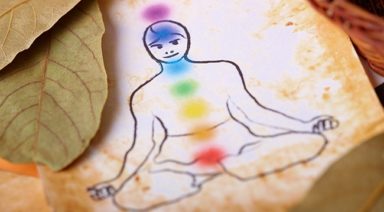Goddess Empowerment: Secret Tools for Attracting What You Want

When I was asked to write for My Yoga on Gaiam TV, it was thrilling to get a writing assignment that inspired me so much. But when I sat down to write, insecurities started taking over: I’m not good enough, Who do I think I am? and the good old, I don’t have what it takes.
Some of these thoughts could come from the repressions of women in the past – what women have gone through, and are still battling in our bodies and consciousness. Women have endured repression since ancient times that it is in our DNA, and I have spent a lifetime learning ways to overcome this, to move forward and change the game! I am not blaming men and repression of the past for something that could have been writer’s block, and I not an angry feminist either. I am an equalist. I believe in equality and walking together with men, not in front or behind, but together.
Because I’ve learned ways to work through the repressions of my ancestors and sisters of the past (and writer’s block), I know what to do. I go to the Goddesses and ask for support.
Yes, I said Goddess, and I don’t care if it sounds woo-woo.
I’ll say it loud and proud – I connect to the Goddesses!
What Goddesses Represent
A Goddess is a female deity. And, for those of you who aren’t keen on idols, I understand. It’s hard to imagine an invisible means of support like this, because we can’t validate or prove it. I grew up a Sikh, and we didn’t do Idol worship, so I get it. So while I can’t prove what this kind of support does for me, I can share a little about what they represent and symbolize.
To me, all Goddesses represent what a woman is truly capable of. Imagine what we’d accomplish with all those arms and qualities of strength. A Goddess represents a woman in her full power, strength and sensuality. She may represent aspects that we want to acquire for ourselves to feel full and strong. Some Goddesses even have weapons. My definition of “weapon” here is an item, tool, or belief that helps to combat life’s challenges and empowers us to move forward in life, like the goddess Ganesha, the remover of obstacles.
Saraswati
First in the series of Goddesses is the one I called forth to help me move forward in writing this article. Her name is Saraswati, the Hindu goddess of knowledge, music, writing, arts and speech. The name Saraswati is derived from the word swar which means voice, tone or note. Another definition of Saraswati comes from saras, meaning “flow” and wati, meaning “she who has flow. Saraswati is the embodiment of communicating eloquently with full creativity.
She is the Goddess of all the creative arts, especially poetry and music, learning and science. She is represented as a graceful woman dressed in white (representing purity), she rides a white swan or peacock. Her weapons are sacred scriptures (a symbol of true knowledge), and the vina (a symbol of music, love and life).
Saraswati is the companion of Brahma, and it was with her knowledge that Brahma created the universe. Just so you know, it’s not only Goddesses I’m hanging with. Their male counterparts are really cool too. The two form a union, and if we were to see the male and female divine as role models in our society, this would solve the imbalance in the world. The tendency is to teeter to one side or the other, and I don’t want to make it seem that I am teetering on the girly side since I’m writing about Goddesses. I am in the middle with both, and when I connect to her, I also connect to him.
You can think of Saraswati as your smart-guide. Her teachings lead with wisdom first, before material desires. She is known not only for academic knowledge, but for divine knowledge which is essential to achieving moksha (liberation of the soul).
Calling Forth the Goddesses
The way I call forth the support from the Goddesses and their teachings is through a simple prayer, conversation, or mantras. The prayer goes something like this: Dear Goddess Saraswati, please come forth and be with me, show me the way to strength and confidence. Please speak to me, teach me and guide me into serving in the best way possible.
Sound easy? It is.
Then I breathe and listen, and follow what I hear. And If I don’t hear anything, I get up and move my body. Movement can be a meditation and dancing is a especially a way I connect with higher powers.
A mantra to Saraswati that I am chanting softly now as a I write is: Aum Aim Namo Devi Saraswatyai.
It’s pronounced: Om I’m Na-mo Day-vi Sar-us-swat-yay.
Rough Translation: Oh! Divine Goddess Saraswati. You so fine, You so fine, you blow my mind, hey Saraswati, hey Saraswati…:)
Keep it light, fun and playful!
No matter what you believe, or how spiritual you are or aren’t you can benefit from having an imaginary friend (perhaps), or talking to a supportive being (Goddess) waiting to hear from you.
Image Credit: Original Painting by Amanda Giacomini
Flowing Through the Throat Chakra with Saraswati

A while back I finally had my Vedic astrology chart done and was informed I had the goddess Saraswati in my chart as well as the lord Hanuman. I love to sing and chant in my classes and lead Kirtan, so this all made sense to me because Hanuman loves to fly and was known for his love of singing. Meanwhile, Saraswati rules the throat chakra and is the goddess of music, clear speech, knowledge, and communication—things I’m always striving towards.
Leading a retreat in Bali, I had been drawn to statues and images of Saraswati and brought some home. I realized that my own need to balance my throat chakra through chanting was an aspect of Saraswati in me. And if you’re ever in need of speaking your truth or communicating more clearly, invoking the essence of Saraswati can be very helpful.
Saraswati and the Sound of Om
At the beginning of everything, when the Universe was a swirling mass of nothing and everything, Brahma stood staring at the chaos. Brahma, of the Holy Trinity of Brahma, Vishnu, and Shiva, was well-known as the Creator and representative of brighter, new beginnings. He stood scratching one of his four heads in confusion. He wasn’t sure how to get started with his task of creating something of a Universe out of a gurgling, swirling, bubbling mass of chaotic energy. Saraswati, who was Brahma’s wife at the time, saw Brahma’s confusion, so she decided to help in her own way.
Brahma heard the sound of a great rushing cascade of water, but looked around and saw nothing. It was from the depths of his being where the water moved and flowed through his throat. A great waterfall poured out of his mouth, and with the waterfall came Saraswati.
She was fascinating and beautiful to behold. Her skin as luminous as the moonlight, her hair as black as night with no moon. She held a stringed instrument in her arms and began playing. And with her music, she spoke. She told Brahma she would give him one sound, which he was to use to create order from chaos. The sound held three syllables: A, U, and M.





































